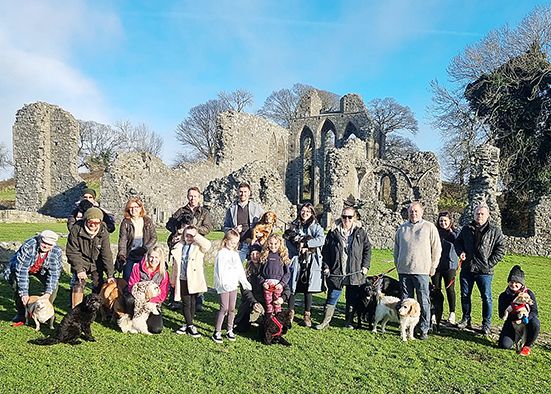Inch Abbey dog walkers hit out at lead restrictions
Inch Abbey dog walkers hit out at lead restrictions
26 January 2022

DOG walkers have criticised a leading government department for insisting that their pets must be kept on a lead at all times while visiting the historic Inch Abbey outside Downpatrick.
An online petition has been launched to have the Department for Communities decision overturned and has been signed by almost 400 people.
Last weekend, dog walkers met with local politicians to discuss their concerns at the ruined Cistercian monastery site on the banks of the Quoile River where signs have been erected reminding dog owners not to allow their pets to run free.
However, the government department which is being heavily criticised has revealed that while the signs were put up recently, the policy requiring dogs to be kept on a lead at Inch Abbey has been in place since 2016.
Regular visitors to the historic site say there are unaware of any incident which resulted in a dog harming any part of the ruins or a member of the public, with all dogs always well controlled by their responsible owners.
They say the grounds are one of the few local places where dogs can exercise while off the lead and where there is no charge to enter what is an important facility for many across the community, in particular, older residents who enjoy much-needed social interaction.
Vanessa Murphy, who started the online petition on behalf of concerned dog walkers, described the dog walking policy as a “dramatic change from the previous policy at Inch Abbey which was to keep dogs under control”.
She continued: “The rationale for this decision remains unclear. The Department for Communities asserts that dogs off the leash cause damage to the ruins, yet despite requests for data supporting this assertion, no information has been provided.
“A compromise has been suggested of a fenced off area for dogs adjacent to the ruins; this request has been denied due to the potential of there
being further ruins underground that dogs off leash could do damage to.”
Vanessa added: “This assertion is puzzling given the many wild animals in the area such as foxes and rabbits and the limited evidence of any damage on this site to date.”
Local councillors Patrick Brown and Cadogan Enright — who organised last weekend’s meeting — share people’s concern about the restrictions in place and have criticised the government department.
Cllr Brown said Inch Abbey had been used by responsible dog owners for many years and there was no evidence of damage to any of the ruins as a result of dogs walking off the lead.
“All this action does is discourage residents and their dogs who enjoy walks in Inch Abbey from using the site,” he suggested.
“I was particularly heartened to hear how Inch Abbey has been a vital space for dog owners who have had mental health challenges during lockdown and how for many years it has been one of the few accessible spaces in the area for dog walkers with disabilities.”
Cllr Brown added: “As we emerge from the pandemic, public bodies should be looking to increase the opening of open spaces
where dogs can get proper exercise and people can socialise, not restrict them.”
Cllr Enright suggested that any issues with dog fouling at Inch Abbey were the consequence of a “lack of enforcement of irresponsible owners” and should be dealt with as such.
He described a blanket ban on off-the-lead walking as “nonsensical” and confirmed that he and
Cllr Brown will be writing to the Department of Communities to outline their total opposition to the band on dogs being allowed off the lead.
Cllr Enright added: “We will be asking officials to these new restrictions and instead put their energy into tackling littering and dog fouling by irresponsible dog owners, rather than chastising responsible ones.”
A Department for Communities spokesperson said the policy requiring dogs to be on leads at Inch Abbey has been in place since 2016.
“The new signs make it clear to visitors that dogs must be kept on a lead at all times, in order to protect above and below ground remains and ensure its enjoyment by all visitors.
“Not all visitors will be comfortable when encountering dogs off-lead and that there is a potential for dogs to damage important below ground archaeology,” the spokesperson added.


